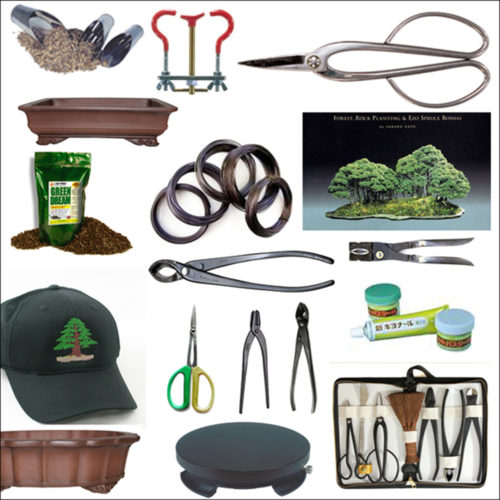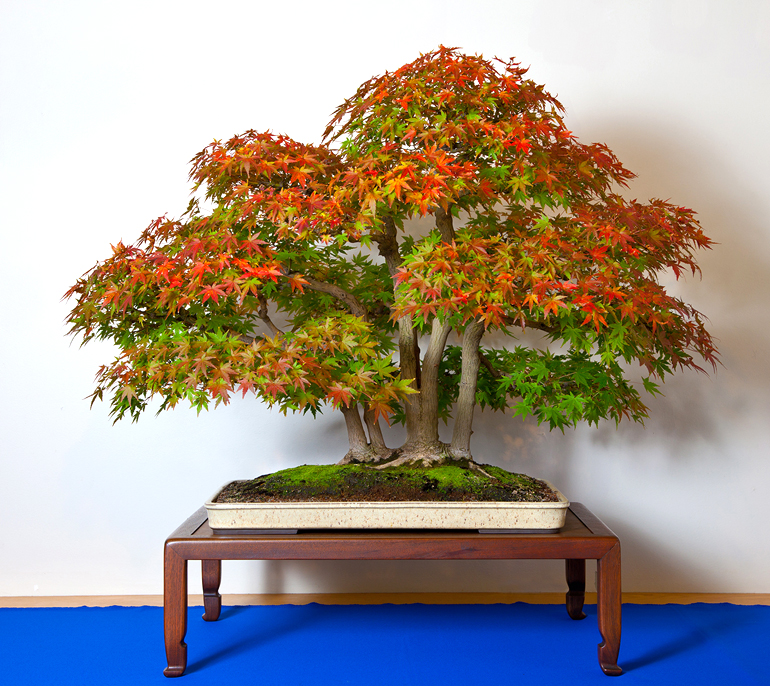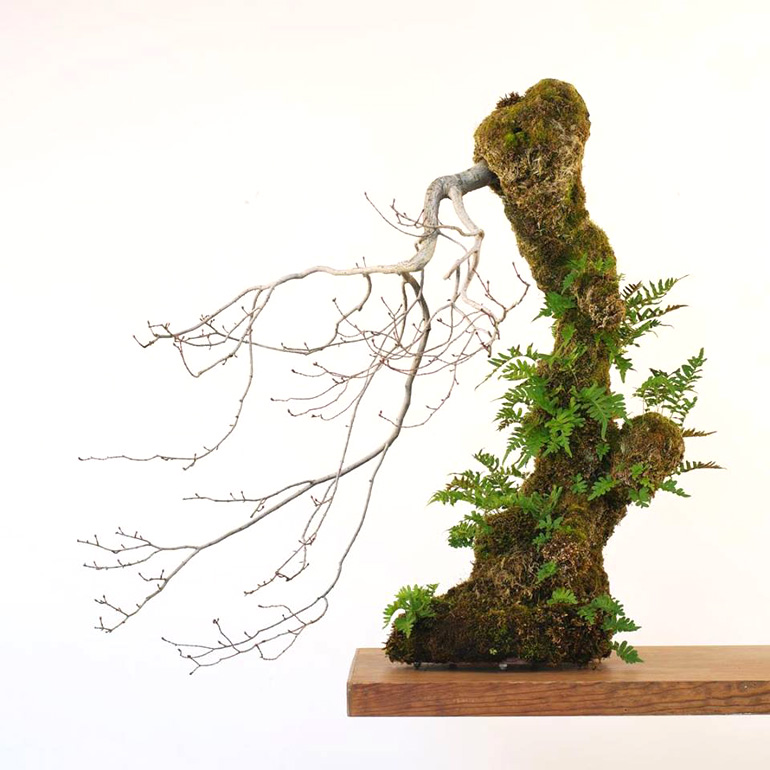
Just a little unconventional? Here's what Michael Hagedorn wrote about this planting... "One of our experiments years ago in a Seasonal class: A collected Vine Maple on an internal armature of nylon boards, wrapped with sphagnum moss and planted with Licorice Ferns...sounds like a dish on a menu..."
Michael Hagedorn is an American bonsai artist, teacher, author and one of the great innovators in our world bonsai community. If Michael is, in his own words “a tad touched in the head,” then maybe we could all use a little crazy
All the photos and quotes in this post are from Michael’s fb timeline
–
 Another example of Michael's not-so-conventional bent. We'll let him explain.... "Shore Pine on a wall...this is one of our tongue-in-cheek bonsai. My apprentice Andrew says, 'Such a weird tree, I love it'. I collected it in Canada and it had a bizarre root system, so planting it on a nylon slab and bolting it onto something just seemed the way to go...there's a post about constructing it on my blog"
Another example of Michael's not-so-conventional bent. We'll let him explain.... "Shore Pine on a wall...this is one of our tongue-in-cheek bonsai. My apprentice Andrew says, 'Such a weird tree, I love it'. I collected it in Canada and it had a bizarre root system, so planting it on a nylon slab and bolting it onto something just seemed the way to go...there's a post about constructing it on my blog"

I cropped this one for a closer look at the trunks and deadwood
 Michael's interests range way beyond bonsai.... "Koi by street artist Jeremy Novy, in a client's bonsai garden. We watched him stencil these on, layer after layer, quickly and with a lot of confidence. Thought it added a bright and playful touch to the garden. With time the erosion of the top layer of paint makes Novy's koi look like they are swimming inside the stone."
Michael's interests range way beyond bonsai.... "Koi by street artist Jeremy Novy, in a client's bonsai garden. We watched him stencil these on, layer after layer, quickly and with a lot of confidence. Thought it added a bright and playful touch to the garden. With time the erosion of the top layer of paint makes Novy's koi look like they are swimming inside the stone."
 Again, the the words of the artist himself... "Intaglio print from the early college days, just as I got into ceramics. I was quite taken with the Redbuds of Upstate New York, and remember looking up into the flowering branches of one small tree on the campus of Hamilton College, making a quick sketch, and scampering off to the print studio. I do less scampering now but enjoyed finding this the other day. Did a lot of tree drawing back in high school."
Again, the the words of the artist himself... "Intaglio print from the early college days, just as I got into ceramics. I was quite taken with the Redbuds of Upstate New York, and remember looking up into the flowering branches of one small tree on the campus of Hamilton College, making a quick sketch, and scampering off to the print studio. I do less scampering now but enjoyed finding this the other day. Did a lot of tree drawing back in high school."
 I know this to be one of Michael's favorite trees. His caption for the New Year.... "Some cheer for the New Year in the form of a dwarf flowering quince 'Chojubai'---happy holidays everyone!"
I know this to be one of Michael's favorite trees. His caption for the New Year.... "Some cheer for the New Year in the form of a dwarf flowering quince 'Chojubai'---happy holidays everyone!"
 I like this twisted tree a lot. I think the words 'simple and unpretentious' suit it, but maybe you can provide your own words. Here's what Michael wrote... "Ponderosa Pine collected by the Backcountry Bonsai guys, styled years ago in a Seasonal class. Much of the deadwood was hiding under bark and was created courtesy of borers of the Rocky Mountains. We've written them a thank you note but the posting address was a bit vague."
I like this twisted tree a lot. I think the words 'simple and unpretentious' suit it, but maybe you can provide your own words. Here's what Michael wrote... "Ponderosa Pine collected by the Backcountry Bonsai guys, styled years ago in a Seasonal class. Much of the deadwood was hiding under bark and was created courtesy of borers of the Rocky Mountains. We've written them a thank you note but the posting address was a bit vague."
 Michael's innovation shows up all over the place including in this Micro Home he choses to live in so his apprentices can live the main house.... His own words again... "New doors on the micro home, next set in tomorrow.Ya, I know, crazy, no need to tell me: two sets of oversized French doors on a building only 24' long says something about 1. Being a tad touched in the head. 2. Liking the outdoors. 3. Not minding wasps inside the house."
Michael's innovation shows up all over the place including in this Micro Home he choses to live in so his apprentices can live the main house.... His own words again... "New doors on the micro home, next set in tomorrow.Ya, I know, crazy, no need to tell me: two sets of oversized French doors on a building only 24' long says something about 1. Being a tad touched in the head. 2. Liking the outdoors. 3. Not minding wasps inside the house."







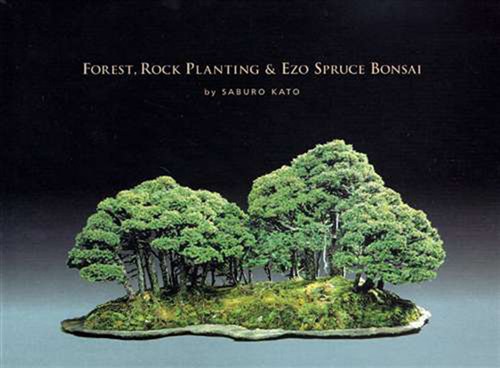

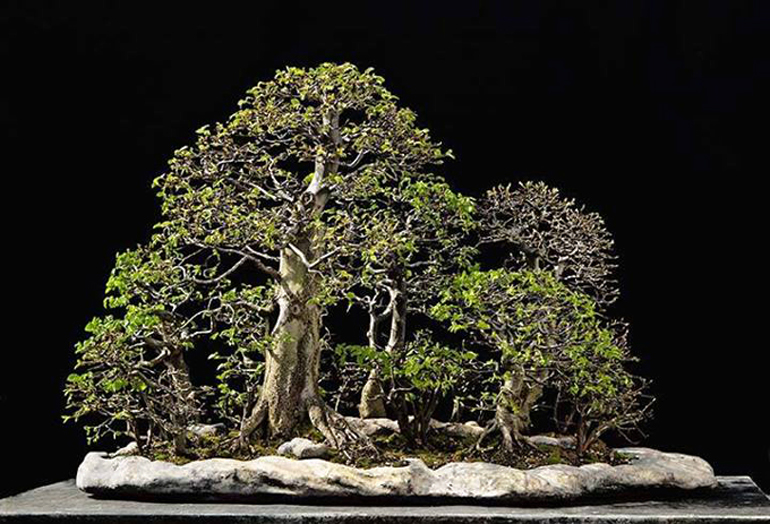














 This might pass as artistic, but it's really just a miserably failed photoshop effort. The bonsai drawing is by
This might pass as artistic, but it's really just a miserably failed photoshop effort. The bonsai drawing is by 

 Another example of Michael's not-so-conventional bent. We'll let him explain.... "Shore Pine on a wall...this is one of our tongue-in-cheek bonsai. My apprentice Andrew says, 'Such a weird tree, I love it'. I collected it in Canada and it had a bizarre root system, so planting it on a nylon slab and bolting it onto something just seemed the way to go...there's a post about constructing it on my blog"
Another example of Michael's not-so-conventional bent. We'll let him explain.... "Shore Pine on a wall...this is one of our tongue-in-cheek bonsai. My apprentice Andrew says, 'Such a weird tree, I love it'. I collected it in Canada and it had a bizarre root system, so planting it on a nylon slab and bolting it onto something just seemed the way to go...there's a post about constructing it on my blog"
 Michael's interests range way beyond bonsai.... "Koi by street artist Jeremy Novy, in a client's bonsai garden. We watched him stencil these on, layer after layer, quickly and with a lot of confidence. Thought it added a bright and playful touch to the garden. With time the erosion of the top layer of paint makes Novy's koi look like they are swimming inside the stone."
Michael's interests range way beyond bonsai.... "Koi by street artist Jeremy Novy, in a client's bonsai garden. We watched him stencil these on, layer after layer, quickly and with a lot of confidence. Thought it added a bright and playful touch to the garden. With time the erosion of the top layer of paint makes Novy's koi look like they are swimming inside the stone." Again, the the words of the artist himself... "Intaglio print from the early college days, just as I got into ceramics. I was quite taken with the Redbuds of Upstate New York, and remember looking up into the flowering branches of one small tree on the campus of Hamilton College, making a quick sketch, and scampering off to the print studio. I do less scampering now but enjoyed finding this the other day. Did a lot of tree drawing back in high school."
Again, the the words of the artist himself... "Intaglio print from the early college days, just as I got into ceramics. I was quite taken with the Redbuds of Upstate New York, and remember looking up into the flowering branches of one small tree on the campus of Hamilton College, making a quick sketch, and scampering off to the print studio. I do less scampering now but enjoyed finding this the other day. Did a lot of tree drawing back in high school." I know this to be one of Michael's favorite trees. His caption for the New Year.... "Some cheer for the New Year in the form of a dwarf flowering quince 'Chojubai'---happy holidays everyone!"
I know this to be one of Michael's favorite trees. His caption for the New Year.... "Some cheer for the New Year in the form of a dwarf flowering quince 'Chojubai'---happy holidays everyone!" I like this twisted tree a lot. I think the words 'simple and unpretentious' suit it, but maybe you can provide your own words. Here's what Michael wrote... "Ponderosa Pine collected by the Backcountry Bonsai guys, styled years ago in a Seasonal class. Much of the deadwood was hiding under bark and was created courtesy of borers of the Rocky Mountains. We've written them a thank you note but the posting address was a bit vague."
I like this twisted tree a lot. I think the words 'simple and unpretentious' suit it, but maybe you can provide your own words. Here's what Michael wrote... "Ponderosa Pine collected by the Backcountry Bonsai guys, styled years ago in a Seasonal class. Much of the deadwood was hiding under bark and was created courtesy of borers of the Rocky Mountains. We've written them a thank you note but the posting address was a bit vague." Michael's innovation shows up all over the place including in this Micro Home he choses to live in so his apprentices can live the main house.... His own words again... "New doors on the micro home, next set in tomorrow.Ya, I know, crazy, no need to tell me: two sets of oversized French doors on a building only 24' long says something about 1. Being a tad touched in the head. 2. Liking the outdoors. 3. Not minding wasps inside the house."
Michael's innovation shows up all over the place including in this Micro Home he choses to live in so his apprentices can live the main house.... His own words again... "New doors on the micro home, next set in tomorrow.Ya, I know, crazy, no need to tell me: two sets of oversized French doors on a building only 24' long says something about 1. Being a tad touched in the head. 2. Liking the outdoors. 3. Not minding wasps inside the house."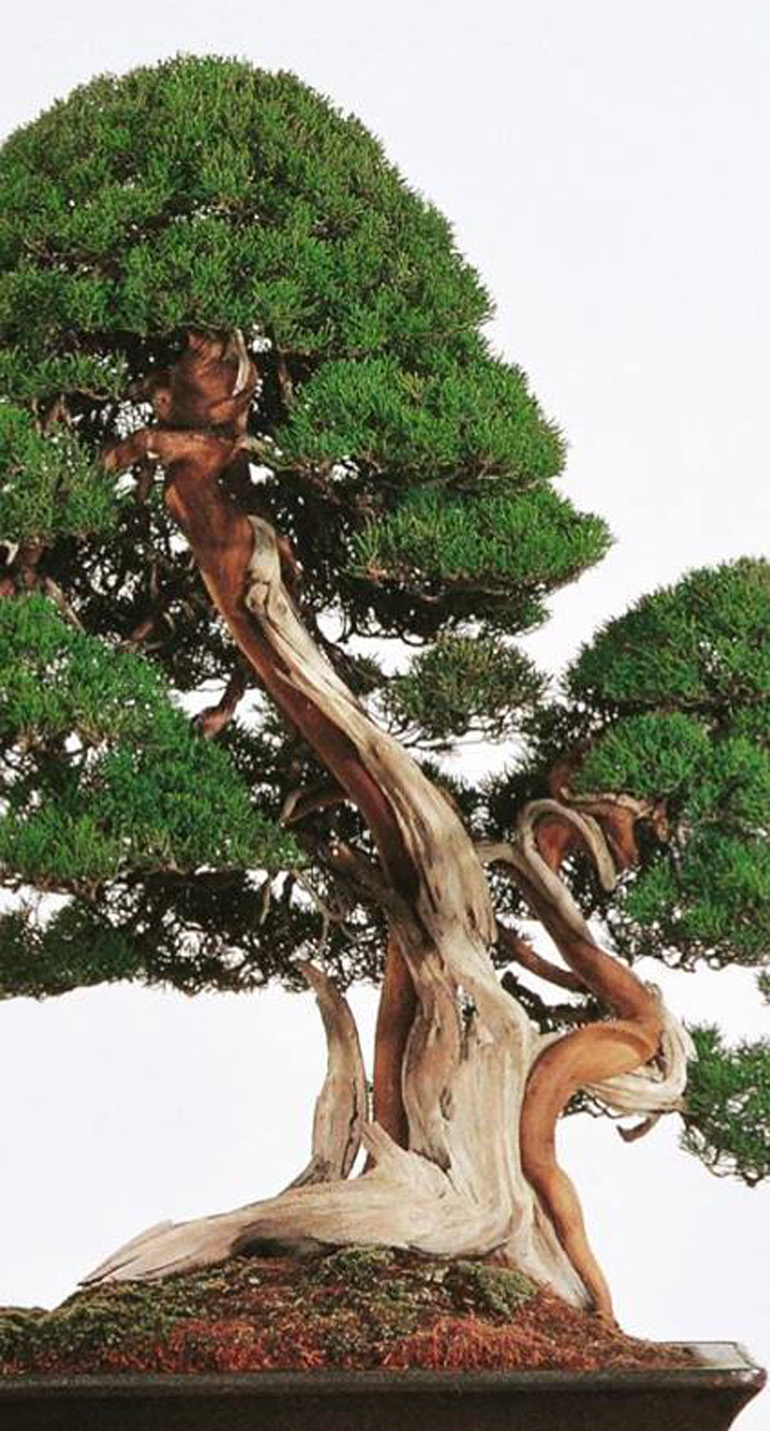





 Ponderosa Pine bonsai displayed by Mike Andrews at the 2018 Mid Atlantic Bonsai Festival and awarded the President's Award. The sculpture is bronze hares frolicking in springtime by Paul Jenkins. The stand is by David Knittle
Ponderosa Pine bonsai displayed by Mike Andrews at the 2018 Mid Atlantic Bonsai Festival and awarded the President's Award. The sculpture is bronze hares frolicking in springtime by Paul Jenkins. The stand is by David Knittle

